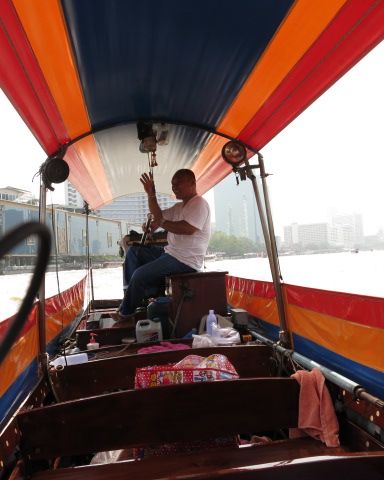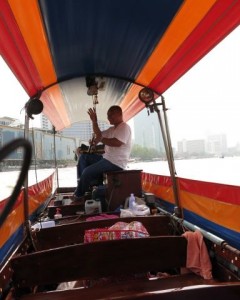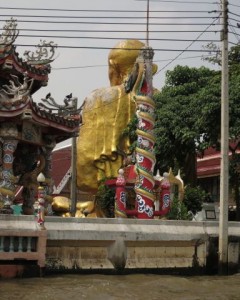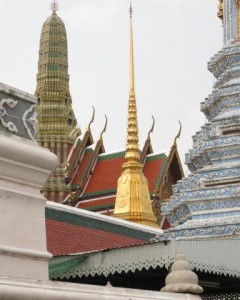
28 Oct TIO Bangkok: Day #2, Long-tailed Boat & Grand Palace
 Day #2 began with a ride in a long-tailed boat along the canals of Chaophraya River, a rite of passage for Bangkok virgins. The tour guide representative at our hotel, again the Royal Orchid Sheraton, arranged the hour-long tour.
Day #2 began with a ride in a long-tailed boat along the canals of Chaophraya River, a rite of passage for Bangkok virgins. The tour guide representative at our hotel, again the Royal Orchid Sheraton, arranged the hour-long tour.
Long-tailed boats or Ruea hang Yao are a type of watercraft native to Southeast Asia. The vessels, which use a second-hand car or truck engine as their power plant, look like canoes on steroids.
The good news: The sights en route provide a snapshot of river life past and present. These include Wat Arun Palace; a fish farm, where your driver will only be too glad to have you feed the fish for an extra 20 baht or about 66 cents for the loaf of bread he carried along for the occasion; and the royal barge museum. Luxury hotels and apartments line the water adjacent to shanties where the other half lives. The excursion is a study in contrasts.
 On the flip side, the river is filled with sewerage, which fights for primacy in your nostrils with gas fumes from the boat’s engine. Take the ride because it’s a must – but only after you have had time to digest breakfast. (I didn’t and felt a bit of initial seasickness.) Just close your nose and open your mind and heart to the joy of discovery.
On the flip side, the river is filled with sewerage, which fights for primacy in your nostrils with gas fumes from the boat’s engine. Take the ride because it’s a must – but only after you have had time to digest breakfast. (I didn’t and felt a bit of initial seasickness.) Just close your nose and open your mind and heart to the joy of discovery.
The hotel arranged for the boat “captain” to drop us off at the pier near our next stop, Bangkok’s Grand Palace.
When in New York for the first time, you visit the Statue of Liberty, the Empire State Building and Central Park. In Athens, it’s the Acropolis; In Venice, St Mark’s Square. In Bangkok, your bucket list should include a tour of the Old City and especially the Grand Palace and Wat Phra Kaeo, home of the Buddhist country’s most venerated image, the Emerald Buddha.
 Construction on the site began in 1782 to mark the founding of the new capital – and to provide a resting place for the aforementioned Buddha, whose historical records trace his wanderings to Cambodia and Vientiane before a celebrated return to Thailand in the 18th century.
Construction on the site began in 1782 to mark the founding of the new capital – and to provide a resting place for the aforementioned Buddha, whose historical records trace his wanderings to Cambodia and Vientiane before a celebrated return to Thailand in the 18th century.
The Grand Palace is a spectacular city within a city, a dazzling complex of halls, religious structures, and open pavilions for contemplation, featuring gilt figures, bronzes, and murals depicting the Ramakien, Thailand’s national epic. The Grand Palace was once the residence of the royal family (until 1925), which now lives in Dusit.
Just for the record, the Emerald Buddha was not fashioned from bling. He is a solid piece of jade. Legend has it that some time in the 15th century, lightening hit a chedi (or stupa) of Wat Phra Kaeo in Chiang Rai (in Northern Thailand), revealing a simple stucco image. When the plaster flaked, the jadeite form was revealed.
A prophesy suggests the Emerald Buddha brings “prosperity and pre-eminence to each country in which it resides,” so the icon is considered the protector of the country.
But who protects tourists like us from the army of scalawags who line the streets near the Grand Palace ready to pounce? The running game is to tell unsuspecting strangers the Grand Palace is closed and suggest alternative stops – such as shops where they get kickbacks on sales.
Our hotel was careful to tip us off about scammers.
Go, but be forewarned.
Before exiting the grounds, we made a quick pass through the Queen Sirikit Museum of Textiles on the outskirts of the Grand Palace complex. The museum’s ostensible mission is to collect, display and preserve textiles from all over Asia, with a special emphasis on the textiles of and related to the Royal Court. The subtext tells the tale of the queen who was once a serious babe who wore serious threads (on display) and was on “Best Dressed” lists in the Sixties, right alongside Jackie O.


Sorry, the comment form is closed at this time.